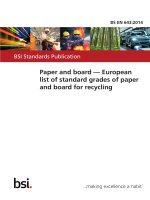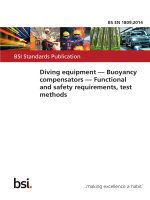Bsi bs en 16570 2014
Bạn đang xem bản rút gọn của tài liệu. Xem và tải ngay bản đầy đủ của tài liệu tại đây (969.77 KB, 20 trang )
BS EN 16570:2014
BSI Standards Publication
Information technology
— Notification of RFID —
The information sign and
additional information to be
provided by operators of RFID
application systems
BS EN 16570:2014
BRITISH STANDARD
National foreword
This British Standard is the UK implementation of EN 16570:2014.
The UK participation in its preparation was entrusted to Technical
Committee IST/34, Automatic identification and data capture
techniques.
A list of organizations represented on this committee can be
obtained on request to its secretary.
This publication does not purport to include all the necessary
provisions of a contract. Users are responsible for its correct
application.
© The British Standards Institution 2014. Published by BSI Standards
Limited 2014
ISBN 978 0 580 81785 4
ICS 35.240.60
Compliance with a British Standard cannot confer immunity from
legal obligations.
This British Standard was published under the authority of the
Standards Policy and Strategy Committee on 31 July 2014.
Amendments issued since publication
Date
Text affected
BS EN 16570:2014
EN 16570
EUROPEAN STANDARD
NORME EUROPÉENNE
EUROPÄISCHE NORM
July 2014
ICS 35.240.60
English Version
Information technology - Notification of RFID - The information
sign and additional information to be provided by operators of
RFID application systems
Technologies de l'information - Notification d'identification
par radiofréquence (RFID) - Signe informationnel et
informations complémentaires devant être délivrées par les
exploitants de systèmes d'application d'identification RFID
Informationstechnik - Notifizierung von RFID - Das
Informationszeichen und zusätzliche Informationen, die von
den Betreibern von RFID-Anwendungssystemen
bereitgestellt werden müssen
This European Standard was approved by CEN on 14 May 2014.
CEN members are bound to comply with the CEN/CENELEC Internal Regulations which stipulate the conditions for giving this European
Standard the status of a national standard without any alteration. Up-to-date lists and bibliographical references concerning such national
standards may be obtained on application to the CEN-CENELEC Management Centre or to any CEN member.
This European Standard exists in three official versions (English, French, German). A version in any other language made by translation
under the responsibility of a CEN member into its own language and notified to the CEN-CENELEC Management Centre has the same
status as the official versions.
CEN members are the national standards bodies of Austria, Belgium, Bulgaria, Croatia, Cyprus, Czech Republic, Denmark, Estonia,
Finland, Former Yugoslav Republic of Macedonia, France, Germany, Greece, Hungary, Iceland, Ireland, Italy, Latvia, Lithuania,
Luxembourg, Malta, Netherlands, Norway, Poland, Portugal, Romania, Slovakia, Slovenia, Spain, Sweden, Switzerland, Turkey and United
Kingdom.
EUROPEAN COMMITTEE FOR STANDARDIZATION
COMITÉ EUROPÉEN DE NORMALISATION
EUROPÄISCHES KOMITEE FÜR NORMUNG
CEN-CENELEC Management Centre: Avenue Marnix 17, B-1000 Brussels
© 2014 CEN
All rights of exploitation in any form and by any means reserved
worldwide for CEN national Members.
Ref. No. EN 16570:2014 E
BS EN 16570:2014
EN 16570:2014 (E)
Contents
Page
Foreword ..............................................................................................................................................................3
Introduction .........................................................................................................................................................4
1
1.1
1.2
1.3
Scope ......................................................................................................................................................5
General ....................................................................................................................................................5
Objective .................................................................................................................................................5
Applicability............................................................................................................................................5
2
Normative references ............................................................................................................................5
3
Terms and definitions ...........................................................................................................................5
4
4.1
4.2
4.3
4.4
4.5
4.5.1
4.5.2
4.6
The Common European RFID Notification Signage System .............................................................7
Introduction ............................................................................................................................................7
Definition of the Common European Notification Signage System .................................................8
The common European RFID notification sign ..................................................................................8
The Common RFID emblem ..................................................................................................................8
Contact Point ..........................................................................................................................................9
General ....................................................................................................................................................9
Name of the operator of the application ..............................................................................................9
Purpose of the application(s) ...............................................................................................................9
5
5.1
5.2
Placement of RFID Signs notifying the presence of RFID interrogators ...................................... 10
General ................................................................................................................................................. 10
Notification of multiple applications in an area ............................................................................... 10
6
6.1
6.2
6.3
Notification of the presence of tags on or in items ......................................................................... 10
Common RFID Emblem ...................................................................................................................... 10
Contact Point ....................................................................................................................................... 11
Scope and purpose............................................................................................................................. 11
7
7.1
7.2
7.3
7.3.1
7.3.2
Additional information: the Information Policy ............................................................................... 11
Summary PIA....................................................................................................................................... 11
Information policy requirements with respect to RFID privacy ..................................................... 11
RFID privacy information and notification within promotional material ....................................... 11
General ................................................................................................................................................. 11
RFID privacy information and notification within sales material and pre-contract
information .......................................................................................................................................... 12
RFID privacy relevant contractual clauses ...................................................................................... 12
Post sale user RFID privacy information including end of use of an item ................................... 13
RFID privacy information and notification to be obtained from manufacturers and other
RFID technology suppliers ................................................................................................................ 14
7.3.3
7.3.4
7.3.5
8
Legibility/Accessibility ....................................................................................................................... 14
Bibliography ..................................................................................................................................................... 15
2
BS EN 16570:2014
EN 16570:2014 (E)
Foreword
This document (EN 16570:2014) has been prepared by Technical Committee CEN/TC 225 “AIDC
technologies”, the secretariat of which is held by NEN.
This European Standard shall be given the status of a national standard, either by publication of an identical
text or by endorsement, at the latest by January 2015, and conflicting national standards shall be withdrawn at
the latest by January 2015.
Attention is drawn to the possibility that some of the elements of this document may be the subject of patent
rights. CEN [and/or CENELEC] shall not be held responsible for identifying any or all such patent rights.
This document has been prepared under a mandate given to CEN by the European Commission and the
European Free Trade Association.
This European Standard is one of a series of related deliverables, which together comprise M/436 Phase 2.
The other deliverables are:
—
EN 16571, Information technology — RFID privacy impact assessment process;
—
EN 16656, Information technology — Radio frequency identification for item management — RFID
Emblem (ISO/IEC 29160:2012, modified);
—
CEN/TR 16669, Information technology — Device interface to support ISO/IEC 18000-3,
—
CEN/TR 16670, Information technology — RFID threat and vulnerability analysis;
—
CEN/TR 16671, Information technology — Authorisation of mobile phones when used as RFID
interrogators;
—
CEN/TR 16672, Information technology — Privacy capability features of current RFID technologies;
—
CEN/TR 16673 1 , Information technology — RFID privacy impact assessment analysis for specific
sectors;
—
CEN/TR 16674, Information technology — Analysis of privacy impact assessment methodologies
relevant to RFID;
—
CEN/TR 16684 2 , Information technology — Notification of RFID — Additional information to be provided
by operators;
—
CEN/TS 16685, Information technology — Notification of RFID — The information sign to be displayed in
areas where RFID interrogators are deployed.
)
)
According to the CEN/CENELEC Internal Regulations, the national standards organizations of the following
countries are bound to implement this European Standard: Austria, Belgium, Bulgaria, Croatia, Cyprus, Czech
Republic, Denmark, Estonia, Finland, Former Yugoslav Republic of Macedonia, France, Germany, Greece,
Hungary, Iceland, Ireland, Italy, Latvia, Lithuania, Luxembourg, Malta, Netherlands, Norway, Poland, Portugal,
Romania, Slovakia, Slovenia, Spain, Sweden, Switzerland, Turkey and the United Kingdom.
1) CEN/TR 16673 contains practical examples of PIA systems.
2) CEN/TR 16684 contains practical examples of notification signage systems.
3
BS EN 16570:2014
EN 16570:2014 (E)
Introduction
In response to the growing deployment of RFID systems in Europe, the European Commission published in
2007 the Communication COM(2007) 96 ‘RFID in Europe: steps towards a policy framework’. This
Communication proposed actions to overcome barriers to wider take-up of RFID to benefit society and the
economy whilst incorporating appropriate privacy, health and environmental safeguards.
In December 2008, the European Commission addressed Mandate M/436 to CEN, CENELEC and ETSI in the
field of ICT as applied to RFID systems.
The Mandate addresses the data protection, privacy and information policy aspects of RFID, and has been
executed in two phases.
Phase 1, completed in May 2011, identified the work needed to produce a complete framework of future RFID
standards. The Phase 1 results are contained in the ETSI Technical Report TR 187 020, which was published
in May 2011.
Phase 2 delivered the execution of the standardization work programme identified in the first phase.
This European Norm is one of 11 deliverables of EC Mandate M/436 RFID Phase 2. It builds on the research
undertaken in the related Technical Report CEN/TR 16684:2014, Information technology — Notification of
RFID — Additional information to be provided by operators.
It is intended that the procedures defined in this EN shall be used by individual RFID operators - or by entire
sectors - for notification of the presence of RFID applications.
4
BS EN 16570:2014
EN 16570:2014 (E)
1
Scope
1.1 General
The scope of this EN is to define the requirements for a Common European Notification Signage system to be
used by operators of RFID application systems deployed within the EU Member States.
1.2 Objective
The objective of this EN is to provide enterprises, both large and small, with a common and accessible
framework for the design and display of RFID notification signs.
In addition to the information placed on the sign, the framework includes the information policy - needed to
answer enquiries received from individuals accessing the contact point noted on the sign itself. This minimizes
the volume of information written on the sign.
This European Standard defines:
a)
the details of data and graphics that shall be included on the signage;
b)
the presentational requirements for the signage, taking account of the need;
1)
to provide a practical solution given constraints on print technique and print area;
2)
for a consistent common and recognisable signage;
c)
means to support accessibility;
d)
the structure and content of an information policy to meet the informational needs of individuals with
respect to RFID privacy.
1.3 Applicability
This EN provides an application-agnostic framework which may be used by all enterprises operating RFID
applications in the European Union.
2
Normative references
The following documents, in whole or in part, are normatively referenced in this document and are
indispensable for its application. For dated references, only the edition cited applies. For undated references,
the latest edition of the referenced document (including any amendments) applies.
EN 16571, Information technology — RFID privacy impact assessment process
EN 16656:2014, Information technology — Radio frequency identification for item management — RFID
Emblem (ISO/IEC 29160:2012, modified)
3
Terms and definitions
For the purposes of this document, the following terms and definitions apply.
3.1
common European RFID notification emblem
graphic design which notifies the presence of radio frequency identification (RFID) systems
5
BS EN 16570:2014
EN 16570:2014 (E)
Note 1 to entry:
This emblem is defined in EN 16656 as the filled general-purpose emblem (Figure B.3). Users of this
European Norm should use EN 16656 rather than ISO/IEC 29160:2012. The EN version contains specific advice
regarding the use of the RFID Emblem in an EU environment, especially in relation to minimum sizing of the emblem.
Note 2 to entry:
The term “emblem” is used to signify that the Common European Emblem is non-commercial and
does not make any statement of interoperability.
3.2
common European RFID notification sign
physical expression of the RFID notification signage system
Note 1 to entry:
It has three elements:
1)
the common European RFID Notification Emblem,
2)
the scope and purpose of the RFID application,
3)
the contact point where further information about the application may be obtained.
3.3
controller or data controller
natural or legal person, public authority or agency, or any other body which alone or jointly with others
determines the purpose and means of the processing of personal data
Note 1 to entry:
Where the purpose and means of the processing are determined by national or Community laws or
regulations the controller or the specific criteria for his nomination may be designated by national or Community Law.
3.4
common European notification emblem
emblem which is used to signify that the Common European Emblem is non-commercial and does not make
any statement of interoperability
3.5
logo
symbol, graphic design or other small design that indicates branding, trademark, or interoperability capability
3.6
operator
RFID application operator
natural or legal person, public authority, agency, or any other body, which, alone or jointly with others,
determines the purposes and means of operating an application, including controllers of personal data using
an RFID application
Note 1 to entry:
At the application level, the identity of the operator is context related.
3.7
personal data
information on a person’s characteristics apart from identity data (name, birth date and place, address,
governmental identification card number, etc.)
Note 1 to entry:
These data include: religious or philosophical beliefs, race, political opinions, health, sexual
orientation, membership of a trade union, personal data connected with a person’s criminal behaviour, personal data
connected with unlawful or objectionable conduct for which a ban has been imposed (a street ban, for example).
3.8
personal data processing
operation or any set of operations upon personal data
6
BS EN 16570:2014
EN 16570:2014 (E)
Note 1 to entry:
These encompass data such as: collecting, recording, organization, storage, adaptation or alteration,
retrieval, consultation, use, disclosure by transmission, dissemination or otherwise making available, alignment or
combination, blocking, erasure or destruction.
3.9
RFID (Radio Frequency Identification)
electro-magnetic radiating waves or reactive field coupling in the radio frequency portion of the spectrum to
communicate to or from a tag through a variety of modulation and encoding schemes to uniquely read the
identity of a radio frequency tag or other data stored on it
3.10
RFID application or application
application that processes data through the use of tags and interrogators, and which is supported by a backend system and a networked communication infrastructure
3.11
RFID interrogator
fixed or mobile data capture and identification device using a radio frequency electromagnetic wave or
reactive field coupling to stimulate and effect a modulated data response from a tag or group of tags
3.12
RFID tag or ‘Tag’ (including contactless cards)
device having the ability to produce a radio signal or a RFID device that re-couples, back- scatters or reflects
(depending on the type of device) and modulates a carrier signal received from an interrogator
Note 1 to entry:
For the purposes of this EN, an RF tag applies to any transponder that is capable of communicating
using the radio frequency portion of the spectrum for communication purposes. As such it applies to any form factor
including cards, phones, etc., that contain a transponder: RF tag, Tag, Transponder, Electronic label, Transponder plus
the information storage mechanism attached to the object.
Note 2 to entry:
‘tag’ or ‘RF tag’.
Although ‘transponder’ is technically the most accurate term, the most common and preferred term is
3.13
information policy
information source maintained by an application operator in order to communicate the scope and purpose of
the application to stakeholders
3.14
consumer durable
item purchased by individual that has multiple use over extended time periods, e.g. fridge, TV, and that may
be subject to in-life service and end-of-life disposal systems
4
The Common European RFID Notification Signage System
4.1 Introduction
The EC Recommendation of May 12th 2009 on the implementation of privacy and data protection principles in
RFID applications calls for increased awareness by citizens and enterprises about the features and
capabilities of RFID.
It notes that parties deploying RFID technology have a responsibility to provide individuals with information on
the use of these applications.
The Common RFID Notification signage system is a key element in notifying individuals of the presence and
intent of RFID systems.
The RFID Recommendation defines two situations where signage is required.
7
BS EN 16570:2014
EN 16570:2014 (E)
—
where RFID interrogators are present;
—
where tags are attached to, or embedded in, items such as retail products, library items, contactless
transport tickets and contactless bank cards.
4.2 Definition of the Common European Notification Signage System
The common European RFID signage system consists of three elements:
—
a common notification emblem which is technology and application agnostic;
—
a description of the purpose of the RFID application being notified;
—
the contact point from which further information regarding the RFID application may be obtained.
4.3 The common European RFID notification sign
The common European RFID notification sign is a context dependent expression of the intent of the common
European RFID notification signage system.
The common RFID notification sign shall conform to the norms of the country where the sign is displayed in
relation to:
—
visibility, legibility and accessibility as applied to trade regulation;
—
language, declaration of relevant laws, decrees, etc.
The common RFID notification sign shall not be regarded as a hazard sign, and shall not utilize
shapes/outlines and/or colours that might imply danger.
4.4 The Common RFID emblem
The Common RFID Emblem shall conform to the general purpose design contained in Figure B.3 of
EN 16656:2014.
The emblem is shown for information in Figure 1 of this EN.
Figure 1 — Graphic for EU Common RFID Notification Emblem
The presence of this emblem on the common RFID notification sign is mandatory to achieve compliance with
this EN.
8
BS EN 16570:2014
EN 16570:2014 (E)
The Common RFID Emblem shall not be used to imply interoperability or compliance with any RFID system or
data structure. Therefore there is no requirement to remove any existing RFID application logos when
implementing the common RFID notification emblem.
The emblem element may be used on its own where the scope and contact point are already known to an
individual, e.g. where this information is known to an individual as a result of the operator including this
information in the terms and conditions for using the system, e.g. public transport and bank contactless cards.
4.5 Contact Point
4.5.1
General
The Contact Point element of the sign shall display:
—
the legal name of the entity operating the RFID application and the job title (but not the name) of the
person responsible for communicating with the public;
—
at least one method of direct contact generally available to an individual.
The contact methodology implemented shall always permit person-to-person contact during normal business
hours: this may include telephone number, postal address or e-mail address.
Where a telephone number is provided, this number shall be a toll-free or standard rate number in the country
where the sign is displayed.
Additionally, indirect methods such as websites may be used to provide answers to FAQs regarding the
application. These FAQ answers should include a direct method of contact with the application operator.
The Contact Point information shall be displayed as human readable text in a font and type size that conforms
to the legibility and accessibility regulations for the country in which the sign is located. Additionally, machinereadable methods such as QR code may be used.
It is recognized that the application operator, especially in the case of small enterprises, buying groups,
franchises, etc., may delegate the contact point task to third parties such as call centres. However, it should
be noted that this does not reduce the legal responsibilities of the application operator in terms of compliance
with Data Protection and Privacy regulations.
4.5.2
Name of the operator of the application
The Application Operator’s name displayed shall be the name of an EU registered company.
No other information in any form shall be present on the same row as the RFID application operator’s name or
company identifier.
Only one RFID application operator’s name and identifier shall be displayed on any particular common
European RFID notification sign.
RFID operators may delegate the point of contact function to a third party. This permits one sign to notify the
presence of RFID interrogators operated by several operators in the same space, e.g. public transport hubs,
shopping malls. However the responsibility for compliance with this EN remains with the RFID operator.
4.6 Purpose of the application(s)
The scope and purpose of the application(s) shall be described on the sign, e.g.:
—
RFID systems operate in this area for reasons of inventory control and product security;
9
BS EN 16570:2014
EN 16570:2014 (E)
—
RFID systems operate in this area for control of tickets;
—
RFID systems operate in this area to improve availability of lending items.
The Application Scope and Purpose information shall be displayed as human readable text in a font type size
that conforms to the legibility and accessibility regulations for the country in which the sign is located.
Additionally, machine-readable methods such as QR code may be used.
The physical presence of this information on a RFID notification sign or tagged item is context dependent.
Where the purpose of the system is notified in advance, e.g. by terms and conditions relating to the issue of
transport and/or financial cards to specific individuals, then a common RFID notification sign may not need to
repeat this information. This is particularly relevant where the information to be conveyed is complex, and the
available space to carry the printed information is limited.
5
Placement of RFID Signs notifying the presence of RFID interrogators
5.1 General
RFID Notification signs shall be placed at all entrances to areas where fixed and/or mobile RFID interrogators
may be operating and to which the public have access.
The RFID notification signs do not purport to define the boundaries of the area where tags may be activated
by the notified interrogators.
The sign shall be compliant with relevant trading regulations in the country where the sign is displayed.
5.2 Notification of multiple applications in an area
In public areas such as shopping malls, public transport stations, multiple RFID applications may be found in
the same area.
Where one operator has multiple applications, compliance with this EN may be achieved by listing the scope
and purpose of the several applications on the notification sign together with the contact point of the operator.
Where several RFID applications are located in the same space, but by different operators, compliance with
this EN may be achieved either by each operator displaying their own notification sign, or by the various
operators delegating the notification task of signage and contact point to a third party, e.g. the shopping mall
operator, train operating company.
6
Notification of the presence of tags on or in items
6.1 Common RFID Emblem
The presence of a RFID transponder of any type, frequency or powering technique placed on or contained in
an item shall be notified by the application of the common RFID notification emblem to the tagged item.
The minimum size of the notification emblem when applied to an item carrying a RFID transponder shall be
(5 x 5) mm.
If the tagged item is contained within secondary packaging, then this packaging shall also display the
notification sign.
10
BS EN 16570:2014
EN 16570:2014 (E)
6.2 Contact Point
Additionally the name and contact point of the operator attaching the tag to the item shall be printed on the
item. This contact point is already required for most items sold, hired or otherwise issued in the EU to achieve
compliance with member state trading regulations.
The contact point provided on the tagged item shall provide the same functionality as specified in 4.5.
6.3 Scope and purpose
In general, compliance with this EN does not require a scope and purpose statement to be placed on items
carrying a transponder.
The tagged item is likely to become a part of several applications as it moves along a supply chain, and the
operator of any one of these applications may have limited or no knowledge of these additional applications.
Therefore it is not practical to require a scope and purpose statement to be displayed on the tagged item.
Where the tagged item is a consumer durable and the scope and purpose of the RFID application is
concerned with warranty, planned maintenance and end of life disposal management, the purpose of the
application should be stated on the tagged item.
7
Additional information: the Information Policy
7.1 Summary PIA
Where the application operator has carried out a privacy impact assessment (PIA), the summary PIA
document specified in EN 16571 should be included within the Information Policy of the operator.
7.2 Information policy requirements with respect to RFID privacy
The information policy shall consider the information needs of consumers, citizens and users in relation to the
following:
—
signage information to be provided when physical space on products does not allow signage additional to
the emblem to be provided on the product itself;
—
RFID privacy information and notification within promotional material;
—
RFID privacy information and notification within Sales material and pre-contract information;
—
RFID privacy relevant contractual clauses;
—
Post sale user RFID privacy information including end of use of an item;
—
RFID privacy information and notification to be obtained from manufacturers and RFID technology
suppliers;
—
information accessibility.
7.3 RFID privacy information and notification within promotional material
7.3.1
General
The application operator may wish to advertize or promote the benefits of the RFID capabilities of an item.
11
BS EN 16570:2014
EN 16570:2014 (E)
In that case, any residual risks or issues relating to the use of RFID shall be communicated to the public and
should also be included in the promotional material.
The relevant PIA analysis and report should be the key source for making such decisions about what
information is needed for consumers and the public.
If mitigation measures need to be taken by individuals to bring risks down to acceptable levels then general
statements that “mitigation may be required to maintain privacy” should be considered in promotional material.
7.3.2
RFID privacy information and notification within sales material and pre-contract information
To assist an individual considering whether to purchase a tagged good or agree to use an RFID enabled
service, more detailed information should be contained in the information policy.
Areas to be explicitly considered should include:
a)
notification of any data use where opt out consent is not available;
b)
whether any privacy options affect prices, e.g. if an opt-out means that when data sharing is not
consented to, prices are increased;
c)
the maximum read distances for interrogators and cards and other items containing tags;
d)
any technical factors in the implementation of the tag selection protocols that mean consumer choice to
use the item for RFID reading is, or may be, affected; the most appropriate and effective means of
conveying information to consumers and the public should be considered such as:
1)
brochures;
2)
product information;
3)
organizational websites;
4)
social networking services and Twitter;
5)
employees of the organization;
6)
videos and pictures.
The information policy should ensure that information is easily available and not ‘hidden away’ in small print or
buried in a lot of technical detail.
7.3.3
RFID privacy relevant contractual clauses
Relevant contract conditions to be considered in an information policy with respect to RFID privacy may
include:
a)
statement of rights and responsibilities;
b)
privacy and privacy protection;
c)
sharing your content and information;
d)
registration and account security;
e)
protecting other people's rights;
12
BS EN 16570:2014
EN 16570:2014 (E)
f)
fixed and mobile RFID platforms
g)
invoicing systems
h)
special provisions applicable to other application developers and other operators of applications;
i)
special provisions applicable to advertizers;
j)
termination;
k)
disputes.
7.3.4
Post sale user RFID privacy information including end of use of an item
Depending on the RFID application, the specific tags used for the application and any mitigation measures
that require user action the information policy should consider the following privacy information provision to
individuals:
a)
privacy options – where there are privacy options, then their descriptions with the privacy implications of
those option;
b)
user operating instructions that impact privacy both to maintain privacy or where miss-operation would
reduce privacy;
c)
staff information, training and instructions necessary to maintain individuals’ privacy;
d)
supplementary information on significant residual risks if more detail is required;
e)
information provision to assist consumers in taking mitigation action if consumer purchased mitigation
equipment should be proposed; the information policy should consider information about where to obtain
suitable quality equipment and likely costs;
f)
the information provision that should be made to consumers and members of the public if there is a loss
or leak of data that would allow others to identify or target individuals through the possession of RFID
identifiable items provided by the application operator;
g)
end of use by an individual: what privacy protecting instructions should be provided for waste disposal or
recycling or secondary goods markets, e.g. car boot sales, eBay.
The information policy with respect to RFID privacy should consider the most appropriate and effective means
of conveying information to consumers and the public after individuals choose to purchase goods or use
services. A range of communication methods are available including:
—
user documentation;
—
publicity and news channels;
—
sales outlets;
—
organizational websites;
—
social networking services and Twitter;
—
employees of the organization.
13
BS EN 16570:2014
EN 16570:2014 (E)
7.3.5 RFID privacy information and notification to be obtained from manufacturers and other RFID
technology suppliers
It is recognized that retailers (and other parties), who supply RFID tagged items to the market place, may lack
knowledge of RFID technology and application.
The RFID PIA EN process EN 16571 clarifies this and includes those who write data to a tag and others as
application operators. The information policy good practice identified in Clause 5 should apply to such
operators who could reasonably expect the RFID items they provide ending up in the possession of
consumers or members of the public. In these circumstances supporting information should be made available
to the end providers of the goods sufficient for them to, in turn, provide reasonable information to consumers
enabling informed choice.
8
Legibility/Accessibility
The content and legibility of the Common RFID Notification signage shall be compliant with relevant EU and
National law and regulation.
Existing National regulations within the EU define the meaning of legibility in relation to the marking of items,
both for normally sighted and impaired vision citizens.
14
BS EN 16570:2014
EN 16570:2014 (E)
Bibliography
[1]
CEN/TR 16684:2014, Information technology — Notification of RFID — Additional information to be
provided by operators
[2]
Directive 95/46/EC of the European Parliament and of the Council of 24 October 1995 on the
protection of individuals with regard to the processing of personal data and on the free movement of
such data “Privacy Impact Assessment Handbook”
[3]
EC Directive 95/46/EC on the protection of individuals with regard t the processing of personal data
and on the free movement of such data; 24 October 1995
[4]
Working document on data protection issues related to RFID technology,” Article 29 Data Protection
Working
Party,
19
January
2005,
10107/05/EN
WP
105,
Available
from:
/>
[5]
COMMUNICATION FROM THE COMMISSION TO THE EUROPEAN PARLIAMENT, THE COUNCIL, THE EUROPEAN
ECONOMIC AND SOCIAL COMMITTEE, AND THE COMMITTEE OF THE REGIONS. Radio Frequency
Identification (RFID) in Europe: steps towards a policy framework. {SEC(2007) 312}
[6]
Privacy Code of Conduct for RFID Technologies; Toby Stevens; RFID Today, October 2007
[7]
“Commission staff working document accompanying the Commission Recommendation on the
implementation of privacy and data protection principles in Applications supported by radio frequency
identification,” Summary of the Impact Assessment, Commission of the European Communities, 12
May
2009,
SEC(2009)
586,
available
from:
/>
[8]
EC Directive 2009/136/EC amending Directive 2002/22/EC on universal service and user’s rights
relating to electronic communication networks and services
[9]
EC COM(2010)245 final/2 “A Digital Agenda for Europe”
[10]
Guidelines on the use of the common EU RFID sign EU project Race in Europe; December 2010,
available from: />
[11]
EC COM (2011)315 final: “Proposal for a Regulation of the European Parliament and European
Council on European Standardization”
[12]
EC COM (2011)311 final “A strategic vision for European standards: Moving forward to enhance and
accelerate the sustainable growth of the European economy by 2020”
[13]
EC INFSO Draft Version 1; Guidelines on the Use of the Common European RFID sign; 28 July 2011
[14]
Privacy and Data Protection Impact Assessment Framework for RFID Applications, 12 January 2011
[15]
European RFID Guide sets NFC Privacy Guidelines; Eric Doyle; eWeek Europe April 2011
[16]
PRIVACY IMPACT ASSESSMENT FRAMEWORK FOR RFID APPLICATIONS. February 2011, available from:
/>
[17]
The RFID Privacy and Data Protection Impact Assessment Framework in the EU: The Article 29
Working Party and the FTC are in No Rush; February 19th, 2011 by Monique Altheim
15
This page deliberately left blank
This page deliberately left blank
NO COPYING WITHOUT BSI PERMISSION EXCEPT AS PERMITTED BY COPYRIGHT LAW
British Standards Institution (BSI)
BSI is the national body responsible for preparing British Standards and other
standards-related publications, information and services.
BSI is incorporated by Royal Charter. British Standards and other standardization
products are published by BSI Standards Limited.
About us
Revisions
We bring together business, industry, government, consumers, innovators
and others to shape their combined experience and expertise into standards
-based solutions.
Our British Standards and other publications are updated by amendment or revision.
The knowledge embodied in our standards has been carefully assembled in
a dependable format and refined through our open consultation process.
Organizations of all sizes and across all sectors choose standards to help
them achieve their goals.
Information on standards
We can provide you with the knowledge that your organization needs
to succeed. Find out more about British Standards by visiting our website at
bsigroup.com/standards or contacting our Customer Services team or
Knowledge Centre.
Buying standards
You can buy and download PDF versions of BSI publications, including British
and adopted European and international standards, through our website at
bsigroup.com/shop, where hard copies can also be purchased.
If you need international and foreign standards from other Standards Development
Organizations, hard copies can be ordered from our Customer Services team.
Subscriptions
Our range of subscription services are designed to make using standards
easier for you. For further information on our subscription products go to
bsigroup.com/subscriptions.
With British Standards Online (BSOL) you’ll have instant access to over 55,000
British and adopted European and international standards from your desktop.
It’s available 24/7 and is refreshed daily so you’ll always be up to date.
You can keep in touch with standards developments and receive substantial
discounts on the purchase price of standards, both in single copy and subscription
format, by becoming a BSI Subscribing Member.
PLUS is an updating service exclusive to BSI Subscribing Members. You will
automatically receive the latest hard copy of your standards when they’re
revised or replaced.
To find out more about becoming a BSI Subscribing Member and the benefits
of membership, please visit bsigroup.com/shop.
With a Multi-User Network Licence (MUNL) you are able to host standards
publications on your intranet. Licences can cover as few or as many users as you
wish. With updates supplied as soon as they’re available, you can be sure your
documentation is current. For further information, email
BSI Group Headquarters
389 Chiswick High Road London W4 4AL UK
We continually improve the quality of our products and services to benefit your
business. If you find an inaccuracy or ambiguity within a British Standard or other
BSI publication please inform the Knowledge Centre.
Copyright
All the data, software and documentation set out in all British Standards and
other BSI publications are the property of and copyrighted by BSI, or some person
or entity that owns copyright in the information used (such as the international
standardization bodies) and has formally licensed such information to BSI for
commercial publication and use. Except as permitted under the Copyright, Designs
and Patents Act 1988 no extract may be reproduced, stored in a retrieval system
or transmitted in any form or by any means – electronic, photocopying, recording
or otherwise – without prior written permission from BSI. Details and advice can
be obtained from the Copyright & Licensing Department.
Useful Contacts:
Customer Services
Tel: +44 845 086 9001
Email (orders):
Email (enquiries):
Subscriptions
Tel: +44 845 086 9001
Email:
Knowledge Centre
Tel: +44 20 8996 7004
Email:
Copyright & Licensing
Tel: +44 20 8996 7070
Email:









